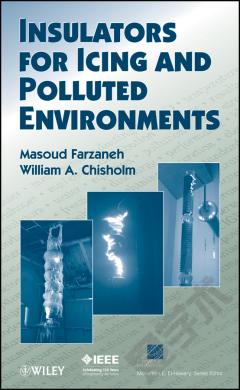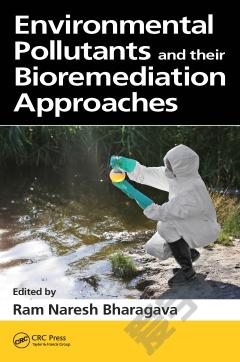Insulators for Icing and Polluted Environments
PREFACE. ACKNOWLEDGMENTS. 1. INTRODUCTION. 1.1. Scope and Objectives. 1.2. Power System Reliability. 1.3. The Insulation Coordination Process: What Is Involved? 1.4. Organization of the Book. 1.5. Precis. 2. INSULATORS FOR ELECTRIC POWER SYSTEMS. 2.1. Terminology for Insulators. 2.2. Classification of Insulators. 2.3. Insulator Construction. 2.4. Electrical Stresses on Insulators. 2.5. Environmental Stresses on Insulators. 2.6. Mechanical Stresses. 3. ENVIRONMENTAL EXPOSURE OF INSULATORS. 3.1. Pollution: What It Is. 3.2. Pollution Deposits on Power System Insulators. 3.3. Nonsoluble Electrically Inert Deposits. 3.4. Soluble Electrically Conductive Pollution. 3.5. Effects of Temperature on Electrical Conductivity. 3.6. Conversion to Equivalent Salt Deposit Density. 3.7. Self-Wetting of Contaminated Surfaces. 3.8. Surface Wetting by Fog Accretion. 3.9. Surface Wetting by Natural Precipitation. 3.10. Surface Wetting by Artificial Precipitation. 4. INSULATOR ELECTRICAL PERFORMANCE IN POLLUTION CONDITIONS. 4.1. Terminology for Electrical Performance in Pollution Conditions. 4.2. Air Gap Breakdown. 4.3. Breakdown of Polluted Insulators. 4.4. Outdoor Exposure Test Methods. 4.5. Indoor Test Methods for Pollution Flashovers. 4.6. Salt-Fog Test. 4.7. Clean-Fog Test Method. 4.8. Other Test Procedures. 4.9. Salt-Fog Test Results. 4.10. Clean-Fog Test Results. 4.11. Effects of Insulator Parameters. 4.12. Effects of Nonsoluble Deposit Density. 4.13. Pressure Effects on Contamination Tests. 4.14. Temperature Effects on Pollution Flashover. 5. CONTAMINATION FLASHOVER MODELS. 5.1. General Classifi cation of Partial Discharges. 5.2. Dry-Band Arcing on Contaminated Surfaces. 5.3. Electrical Arcing on Wet, Contaminated Surfaces. 5.4. Residual Resistance of Polluted Layer. 5.5. dc Pollution Flashover Modeling. 5.6. ac Pollution Flashover Modeling. 5.7. Theoretical Modeling for Cold-Fog Flashover. 5.8. Future Directions for Pollution Flashover Modeling. 6. MITIGATION OPTIONS FOR IMPROVED PERFORMANCE IN POLLUTION CONDITIONS. 6.1. Monitoring for Maintenance. 6.2. Cleaning of Insulators. 6.3. Coating of Insulators. 6.4. Adding Accessories. 6.5. Adding More Insulators. 6.6. Changing to Improved Designs. 6.7. Changing to Semiconducting Glaze. 6.8. Changing to Polymer Insulators. 7. ICING FLASHOVERS. 7.1. Terminology for Ice. 7.2. Ice Morphology. 7.3. Electrical Characteristics of Ice. 7.4. Ice Flashover Experience. 7.5. Ice Flashover Processes. 7.6. Icing Test Methods. 7.7. Ice Flashover Test Results. 7.8. Empirical Models for Icing Flashovers. 7.9. Mathematical Modeling of Flashover Process on Ice-Covered Insulators. 7.10. Environmental Corrections for Ice Surfaces. 7.11. Future Directions for Icing Flashover Modeling. 8. SNOW FLASHOVERS. 8.1. Terminology for Snow. 8.2. Snow Morphology. 8.3. Snow Electrical Characteristics. 8.4. Snow Flashover Experience. 8.5. Snow Flashover Process and Test Methods. 8.6. Snow Flashover Test Results. 8.7 Empirical Model for Snow Flashover. 8.8. Mathematical Modeling of Flashover Process on Snow-Covered Insulators. 8.9. Environmental Corrections for Snow Flashover. 8.10. Case Studies of Snow Flashover. 9. MITIGATION OPTIONS FOR IMPROVED PERFORMANCE IN ICE AND SNOW CONDITIONS. 9.1. Options for Mitigating Very Light and Light Icing. 9.2. Options for Mitigating Moderate Icing. 9.3. Options for Mitigating Heavy Icing. 9.4. Options for Mitigating Snow and Rime. 9.5. Alternatives for Mitigating Any Icing. 10. INSULATION COORDINATION FOR ICING AND POLLUTED ENVIRONMENTS. 10.1. The Insulation Coordination Process. 10.2. Deterministic and Probabilistic Methods. 10.3. IEEE 1313.2 Design Approach for Contamination. 10.4. IEC 60815 Design Approach for Contamination. 10.5. CIGRE Design Approach for Contamination. 10.6. Characteristics of Winter Pollution. 10.7. Winter Fog Events. 10.8. Freezing Rain and Freezing Drizzle Events. 10.9. Snow Climatology. 10.10. Deterministic Coordination for Leakage Distance. 10.11. Probabilistic Coordination for Leakage Distance. 10.12. Deterministic Coordination for Dry Arc Distance. 10.13. Probabilistic Coordination for Dry Arc Distance. 10.14. Case Studies. APPENDIX A: MEASUREMENT OF INSULATOR CONTAMINATION LEVEL. APPENDIX B: STANDARD CORRECTIONS FOR HUMIDITY, TEMPERATURE, AND PRESSURE. APPENDIX C: TERMS RELATED TO ELECTRICAL IMPULSES. INDEX.
{{comment.content}}








 京公网安备 11010802027623号
京公网安备 11010802027623号